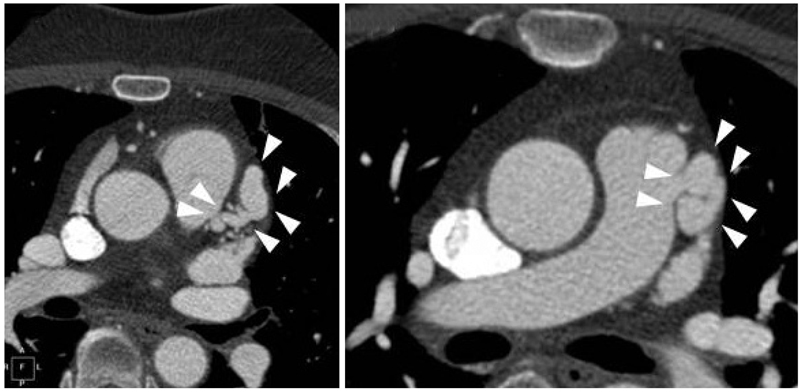Korean Circ J.
2012 Mar;42(3):205-207. 10.4070/kcj.2012.42.3.205.
Contrast Echo-A Simple Diagnostic Tool for a Coronary Artery Fistula
- Affiliations
-
- 1Cardiology Division, National Health Insurance Corporation Ilsan Hospital, Goyang, Korea. drpuooh@hanmail.net
- 2Cardiology Division, Gangnam Severance Hospital, Yonsei University College of Medicine, Seoul, Korea.
- KMID: 2225036
- DOI: http://doi.org/10.4070/kcj.2012.42.3.205
Abstract
- Coronary artery fistulas have been diagnosed with aortography, coronary angiography, and coronary computed tomography (CT). A large fistula can be occasionally found as a mass lesion on echocardiography but cannot be easily confirmed. Here, we report a new diagnostic approach to coronary artery fistulas using a contrast agent and transthoracic echocardiography. Transthoracic echocardiography of a 46-year-old female suffering from dyspnea revealed suspicious small turbulent flow in the main pulmonary artery. Following infusion of a contrast agent, we found whitish flow in the main pulmonary artery during the diastolic phase, and aortic CT revealed two huge right coronary artery fistulas in the main pulmonary artery. A simple diagnostic approach to a coronary artery fistula using contrast agent helped us confirm the diagnosis because of the typical diastolic whitish flow in the pulmonary artery.
MeSH Terms
Figure
Reference
-
1. Wei K, Mulvagh SL, Carson L, et al. The safety of definity and optison for ultrasound image enhancement: a retrospective analysis of 78,383 administered contrast doses. J Am Soc Echocardiogr. 2008. 21:1202–1206.2. Burch GH, Sahn DJ. Congenital coronary artery anomalies: the pediatric perspective. Coron Artery Dis. 2001. 12:605–616.3. Luo L, Kebede S, Wu S, Stouffer GA. Coronary artery fistulae. Am J Med Sci. 2006. 332:79–84.4. Morgan JR, Forker AD, O'Sullivan MJ Jr, Fosburg RG. Coronary arterial fistulas: seven cases with unusual features. Am J Cardiol. 1972. 30:432–436.5. Dresios C, Apostolakis S, Tzortzis S, Lazaridis K, Gardikiotis A. Apical hypertrophic cardiomyopathy associated with multiple coronary artery-left ventricular fistulae: a report of a case and review of the literature. Eur J Echocardiogr. 2010. 11:E9.6. Yamanaka O, Hobbs RE. Coronary artery anomalies in 126,595 patients undergoing coronary arteriography. Cathet Cardiovasc Diagn. 1990. 21:28–40.7. Zenooz NA, Habibi R, Mammen L, Finn JP, Gilkeson RC. Coronary artery fistulas: CT findings. Radiographics. 2009. 29:781–789.8. Kim YH, Lee SH, Kang CH, et al. A case report of coronary arteriovenous fistula. Korean Circ J. 1982. 12:189–192.9. Lee SJ, Her SH, Jin SW, et al. A case of bilateral coronary to pulmonary artery fistulas associated with severe aortic regurgitation. Korean Circ J. 2008. 38:331–334.10. Choi SH, Seo HS, Oh SJ, et al. A case of multiple coronary artery-left ventricular microfistulae demonstrated by transthoracic Doppler echocardiography. Korean Circ J. 2003. 33:338–342.
- Full Text Links
- Actions
-
Cited
- CITED
-
- Close
- Share
- Similar articles
-
- A case of coronary artery-pulmonary artery fistula communicated with aorto-pulmonary fistula via common channel detected by Multidetector row CT (MDCT) and coronary angiography
- Three Cases of Coronary Artery Fistula from Right Coronay to Left Ventricle
- A Case of Double Right Coronary Artery with Arteriovenous Fisula
- Congenital Giant Left Circumflex Artery-to-Left Ventricle Fistula Detected Using Two-Dimensional and Doppler Echocardiography
- A case report of coronary artery fistula to the left ventricle



